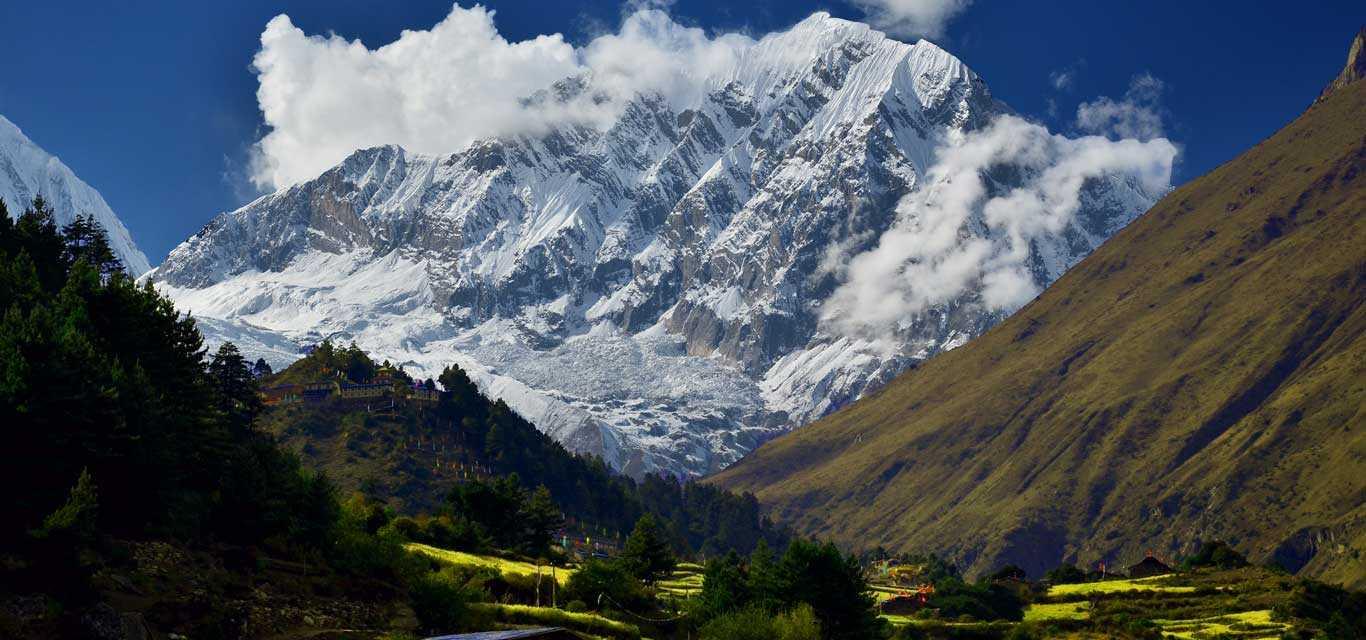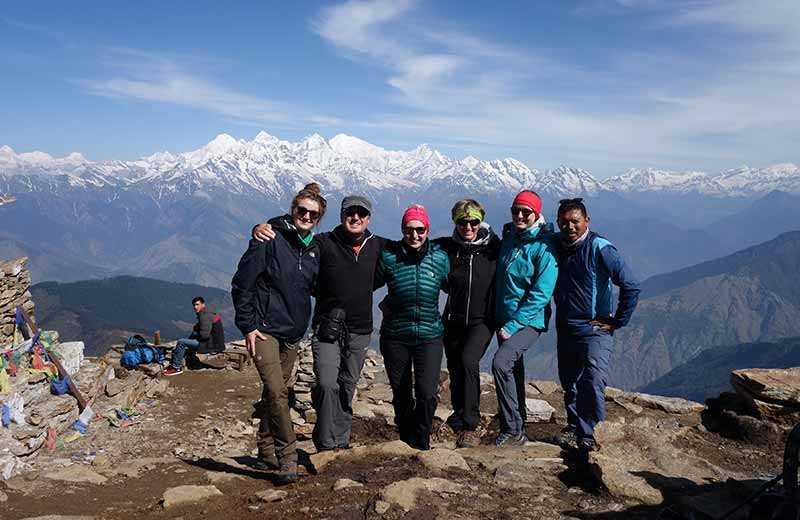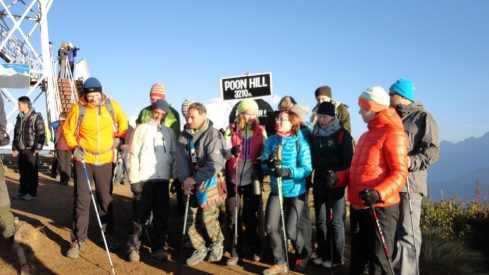Tips for High Altitude Trekking in the Himalayas

Tips for High Altitude Trekking in the Himalayas
Preparing for a high-altitude trek in the Himalayas requires careful planning and a dedicated training regimen to ensure you're physically ready for the challenges ahead. As you ascend to higher altitudes, the air becomes thinner, making it harder for your body to get enough oxygen.
This means your heart has to work harder to pump oxygen-rich blood to your muscles and organs, highlighting the importance of cardiovascular endurance training.
Exercise to focus before High Altitude Treks
Cardiovascular exercises, like running, cycling, or hiking, are essential for building the stamina needed to tackle the sustained climbs and steep ascents characteristic of high-altitude treks.

Improving your cardiovascular endurance will help you maintain energy levels and breathe more efficiently, making your trekking experience smoother and more enjoyable.
In addition to cardio, strength training is also crucial for trekking. The rugged terrain and uneven paths require not only endurance but also muscular strength to navigate safely. Strength training builds the muscles needed to tackle steep inclines, rocky surfaces, and other obstacles you may encounter along the way.
For those new to trekking in Nepal, we recommend a comprehensive two-month training program to prepare adequately. This guide focuses on cardiovascular endurance and strength training, providing a detailed roadmap to assess and improve your fitness levels.
By prioritizing these aspects of training, you'll equip yourself with the physical resilience needed to confidently explore the breathtaking landscapes of the Himalayas.
Why trek in Nepal?
Nepal is home to eight of the world's fourteen highest mountains, each of which stands over 8,000 meters. The country is packed with diverse landscapes, cultures, people, and languages.
From 58 meters to the staggering 8,848 meters above sea level, Nepal offers travelers a variety of experiences over the years. High-altitude treks have become quite popular due to their challenging terrain.
 Famous high-altitude treks include Annapurna Base Camp, Everest Base Camp, Annapurna Circuit, Upper Dolpa, Manaslu Circuit Trek, and more. Any trek above 2,400 meters is considered high altitude.
Famous high-altitude treks include Annapurna Base Camp, Everest Base Camp, Annapurna Circuit, Upper Dolpa, Manaslu Circuit Trek, and more. Any trek above 2,400 meters is considered high altitude.
These treks are tough physically and mentally, but provide a once-in-a-lifetime experience.
Since high-altitude treks involve more risks, it's crucial to prepare well so you can enjoy the journey to the fullest. Here are some tips to help you get started on your exciting trek.
Undergo a Medical Checkup
Prior to embarking on your journey, it is imperative to thoroughly assess and be aware of any pre-existing or underlying health or medical conditions your body may have.
Before commencing, ensure you have the necessary medications and communicate this information to your friends or guide for added precaution.
Establish an Appropriate Training Plan
The demands of trekking call for substantial physical and mental endurance. Accordingly, tailor your training regimen to prepare your body and mind for the specific type of trek you intend to undertake.
Through effective training, you not only enhance your physical fitness but also cultivate the ability to relish the journey and the surrounding scenery.
Also read:
Prioritize Acclimatization
The combination of altitude and attitude can be a precarious mix, particularly in the context of high-altitude treks. Hence, acclimatization becomes pivotal. This involves adapting to the changing environment and elevation.
Allowing your body to acclimate facilitates comfort and optimal performance. Generally, beyond the 3000-meter mark, it is advisable to allocate a day or two for rest and limit ascent to no more than 500 meters per day.
Always adhere to the golden rule! Ascend in altitude gradually to ward off Acute Mountain Sickness (AMS).
Some popular High Altitude Trekking Packages
Proper Hydration Practices- The Key
When navigating higher altitudes, the atmospheric conditions change. The air becomes thinner and drier. This atmospheric shift not only triggers an increase in respiration rate. It is due to reduced oxygen levels, but it also results in a notable loss of body fluids through the breath.

The process of breathing at elevated heights leads to an accelerated evaporation of water from the respiratory system, necessitating a proactive approach to replenish these losses.
In addition to the respiratory fluid loss, the challenges of high altitudes extend to other avenues of moisture depletion. You will face heightened perspiration and increased frequency of urination.
Sweating becomes a natural response of the body to regulate temperature. The body tends to release more fluids through urine at these elevated levels.
To offset the cumulative fluid losses experienced at higher altitudes, it becomes imperative to adopt a consistent and robust hydration routine.
Experts recommend a daily water intake ranging from 4 to 5 liters. However, it is tailored to individual needs and environmental conditions. By adhering to this hydration regimen, individuals can effectively counterbalance the demands placed on the body by the distinctive challenges of high-altitude environments.
Ensuring optimal hydration is not merely a matter of quenching thirst; it is a strategic measure to mitigate the risk of high-altitude sickness. By maintaining a proactive approach to hydration, individuals can contribute significantly to their overall well-being and minimize the potential adverse effects associated with the physiological adjustments demanded by elevated terrains.
The Fundamentals of Altitude Sickness
As you ascend to higher altitudes, it's common to notice changes in your body. You suffer from mild headaches, which are a frequent occurrence. However, it's crucial to familiarize yourself with the various stages of altitude sickness to mitigate potential risks.
Acute Mountain Sickness (AMS) is a common ailment. Most causes of AMS are the decreased oxygen levels at elevations exceeding 2,500 meters. Symptoms include headaches, fatigue, insomnia, shortness of breath, and nausea. The most effective remedy for AMS is acclimatization.

Another altitude-related concern is High Altitude Pulmonary Edema (HAPE). Fluid accumulates in the lungs, making it difficult to breathe. HAPE typically arises at altitudes above 2,500 meters (8,200 ft.).
Symptoms encompass shortness of breath at rest, extreme fatigue, dry or wet cough with frothy sputum, and fever. Untreated HAPE poses a heightened risk of fatality. As such, it necessitates immediate descent to lower altitudes and prompt medical attention if symptoms persist.
High Altitude Cerebral Edema (HACE) is the accumulation of excess fluid in the brain. It manifests in altered mental states. HACE causes coordination difficulties, hallucinations, unconsciousness, confusion, and lethargy. Individuals exhibiting HACE symptoms require urgent evacuation for further medical intervention.
Understanding these stages of altitude sickness equips you with the knowledge to identify and address potential health concerns during high-altitude excursions, enhancing your ability to ensure a safe and enjoyable experience.
Opt for a Steady Pace
It is advisable to approach your trek with a deliberate and unhurried pace. Avoid pushing yourself to the limit and conserve your energy; it's wise to store it for subsequent days.
Rushing increases the likelihood of experiencing altitude sickness, so always adhere to the mantra of "Slow and steady wins the race." This approach not only ensures a safer journey but also enhances your overall trekking experience.
Thoroughly Investigate Food Options
Given the physical demands of high-altitude treks, it is essential to pay close attention to your diet. Consuming foods rich in carbohydrates, along with adequate protein and fat, proves beneficial for your body.
A higher caloric intake aids your body in acclimating to the altitude while providing additional energy. Before embarking on your trek, research the available food options on the trail and consider carrying energy bars and nuts for quick and instant energy boosts.
Read: Trekking Meals and Accommodation in Nepal
Appropriate Attire Selection During High Altitude Trekking
Embarking on high-altitude trekking necessitates meticulous preparation, with a crucial aspect being the thoughtful selection of appropriate clothing. Striking a delicate balance between having too little and too much is imperative for a comfortable and successful trek.
 As you navigate through the high-altitude terrain, the significance of a well-considered base layer becomes paramount. Typically comprising a shirt, undergarments, and socks, the base layer plays a pivotal role in regulating body temperature.
As you navigate through the high-altitude terrain, the significance of a well-considered base layer becomes paramount. Typically comprising a shirt, undergarments, and socks, the base layer plays a pivotal role in regulating body temperature.
Opting for fabrics that are both breathable and non-itchy in this foundational layer can significantly enhance your comfort, ensuring a more enjoyable trekking experience.
Moving beyond the base layer, the mid-layer assumes importance, and a light fleece jacket emerges as a practical choice. This layer proves invaluable during the cooler morning hours and while taking breaks during your trek. Fleece, known for its breathability, not only provides warmth but also dries swiftly, adding to its utility.
Consider incorporating down-insulated jackets into your mid-layer for an extra layer of warmth. These jackets are not only easy to pack but also highly compressible, making them a convenient and efficient addition to your trekking attire.
Their insulating properties surpass many other options, ensuring you stay warm in the chillier segments of your high-altitude journey.
When it comes to the outer layer, opt for water-resistant/breathable shells, which can be considered blessings in the challenging conditions of high altitude.
Designed to withstand drizzle, wind, and various weather conditions, these shells add an extra layer of protection. It's worth noting that the price often corresponds to the durability of these outer layers, emphasizing the importance of investing in quality gear for prolonged and effective use in the demanding high-altitude environment.
Investing in Quality Gear for an Optimal Trekking Experience
When it comes to a trek, the significance of quality gear cannot be overstated, especially when venturing into higher altitudes. Opting for branded bags and boots is not just a matter of style but a practical choice that ensures reliability in the face of challenging conditions.
The proper sizing of both bags and boots emerges as a critical factor, particularly in the context of high-altitude treks. Moreover, adhering to the principle of carrying only essential gear is key to minimizing unnecessary weight and maximizing efficiency.

The importance of good boots cannot be emphasized enough. A well-fitted pair of boots is crucial, considering they are the only gear you'll be wearing for extended hours. Investing in a quality pair is not only advisable but essential for the comfort and well-being of your feet.
Adding an extra pair of supportive insoles enhances the overall support and comfort, especially during prolonged treks. Waterproof boots prove invaluable in unpredictable weather conditions at higher elevations, where sudden changes and encounters with snow are not uncommon.
When it comes to packing, going for the best is the way to go. While it's essential to carry all the necessary gear, investing in branded and, at times, expensive articles ensures reliability and durability, particularly in the demanding conditions of high-altitude treks. Trustworthy gear built for such terrains can make a substantial difference in your overall trekking experience.
Understanding the Landscapes
Understanding the geography of the trek area is a fundamental step in effective trek planning. This knowledge enables you to tailor your preparations, training, and gear choices to the specific challenges of the terrain you will encounter.
Choose the Best Season
Choosing the right season for your trek is another crucial consideration. Conducting thorough research on the place and weather conditions beforehand allows you to make informed decisions.
Each season offers a unique blessing – freshness in monsoon, clarity in autumn, warmth and lengthened days in spring, and a chilly but serene atmosphere in winter. Your preference and desired experience play a pivotal role in determining the most suitable season for your trek.
Pro-Tip: Trek with Pro
Lastly, trekking with professionals adds an extra layer of security and expertise to your journey. Seasoned guides with years of experience in high-altitude trekking understand the associated risks and how to manage them.
Their qualifications and knowledge of the terrain provide valuable assistance, both mentally and physically, ensuring a more secure and enjoyable trekking experience.
Choosing professionalism enhances your overall trekking adventure and instills confidence in tackling rugged terrains.
Read: Do's and Don'ts while Trekking in Nepal
Ensuring Comprehensive Coverage with Insurance
Securing insurance is an indispensable requirement when undertaking high-altitude treks. It is imperative to conduct thorough research before selecting the appropriate insurance policy, assuring a sense of security as you commence your trek.
Considering that medical facilities are often at a considerable distance during high-altitude treks, even a minor complication like a fractured bone may necessitate a helicopter rescue.
The insurance coverage must extend beyond accidents. It encompasses various illnesses that may manifest during the trek. Furthermore, this includes potential issues like gastrointestinal troubles, ensuring a comprehensive safety net for a range of health concerns.
Anticipate the Adventure with Enthusiasm
Approach the planning process with wholehearted dedication. As you set out on the journey, leave behind any lingering worries from home and prepare to embark on a voyage of self-discovery.
The anticipation of fun should be met with careful consideration of safety measures, including comprehensive insurance, fostering an environment conducive to both excitement and peace of mind throughout your trek.
There you have it!
Happy trekking, and may your altitude be high, but your sickness be low!
Read more blogs






